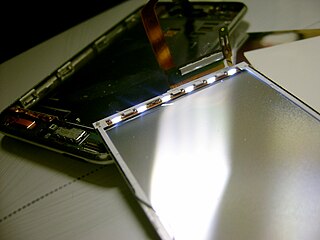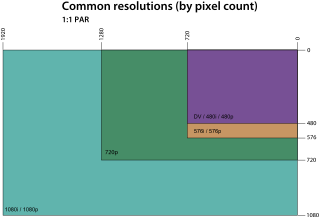Related Research Articles

A computer monitor is an output device that displays information in pictorial form. A monitor usually comprises the visual display, circuitry, casing, and power supply. The display device in modern monitors is typically a thin film transistor liquid crystal display (TFT-LCD) with LED backlighting having replaced cold-cathode fluorescent lamp (CCFL) backlighting. Older monitors used a cathode ray tube (CRT). Monitors are connected to the computer via VGA, Digital Visual Interface (DVI), HDMI, DisplayPort, Thunderbolt, low-voltage differential signaling (LVDS) or other proprietary connectors and signals.
A plasma display panel (PDP) is a type of flat panel display that uses small cells containing plasma: ionized gas that responds to electric fields. Plasma TVs were the first flat panel displays to be released to the public.
Apple Inc. sold a variety of LCD and CRT computer displays in the past. Apple paused production of their own standalone displays in 2016 and partnered with LG to design displays for Macs. In June 2019, the Pro Display XDR was introduced. It is currently the only Apple-branded display available.

A television set or television receiver, more commonly called a television, TV, TV set, telly, or tele, is a device that combines a tuner, display, and loudspeakers, for the purpose of viewing and hearing television broadcasting through satellites or cables, or using it as a computer monitor. Introduced in the late 1920s in mechanical form, television sets became a popular consumer product after World War II in electronic form, using cathode ray tube (CRT) technology. The addition of color to broadcast television after 1953 further increased the popularity of television sets in the 1960s, and an outdoor antenna became a common feature of suburban homes. The ubiquitous television set became the display device for the first recorded media in the 1970s, such as Betamax, VHS and later DVD. It has been used as a display device since the first generation of home computers and dedicated video game consoles in the 1980s. By the early 2010s, flat-panel television incorporating liquid-crystal display (LCD) technology, especially LED-backlit LCD technology, largely replaced CRT and other display technologies. Modern flat panel TVs are typically capable of high-definition display and can also play content from a USB device.
The Sharp Aquos is a product brand name for LCD televisions and component screens, originally sold by Sharp Corporation of Japan. As of January 2019, all Sharp brand TVs sold in the United States are made by Chinese manufacturing company Hisense.

Liquid-crystal-display televisions are television sets that use liquid-crystal displays to produce images. They are, by far, the most widely produced and sold television display type. LCD TVs are thin and light, but have some disadvantages compared to other display types such as high power consumption, poorer contrast ratio, and inferior color gamut.

A backlight is a form of illumination used in liquid crystal displays (LCDs). As LCDs do not produce light by themselves—unlike, for example, cathode ray tube (CRT) displays—they need illumination to produce a visible image. Backlights illuminate the LCD from the side or back of the display panel, unlike frontlights, which are placed in front of the LCD. Backlights are used in small displays to increase readability in low light conditions such as in wristwatches, and are used in smart phones, computer displays and LCD televisions to produce light in a manner similar to a CRT display. A review of some early backlighting schemes for LCDs is given in a report Engineering and Technology History by Peter J. Wild.

The Apple Cinema Display is a line of flat-panel computer monitors developed and sold by Apple Inc. between 1999 and 2011. It was initially sold alongside the older line of Studio Displays, but eventually replaced them. Apple offered 20-, 22-, 23-, 24-, 27- and 30-inch sizes, with the last model being a 27-inch size with LED backlighting.

Bravia is a brand of Sony Visual Products Inc., a wholly owned subsidiary of Sony Corporation, and used for its television products. Its backronym is "Best Resolution Audio Visual Integrated Architecture". All Sony high-definition flat-panel LCD televisions in North America have carried the logo for BRAVIA since 2005. BRAVIA replaces the "LCD WEGA" which Sony used for their LCD TVs until Summer 2005.

16:10 (8:5) is an aspect ratio mostly used for computer displays and tablet computers. The width of the display is 1.6 times its height. This ratio is close to the golden ratio "" which is approximately 1.618.
The Dell Inspiron Mini Series is a line of subnotebook/netbook computers designed by Dell. The series was introduced in September 2008 amidst the growing popularity of low-cost netbook computers introduced by competitors.

A LED-backlit LCD is a liquid-crystal display that uses LED backlighting instead of traditional cold cathode fluorescent (CCFL) backlighting. LED-backlit displays use the same TFT LCD technologies as CCFL-backlit LCDs, but offer a variety of advantages over them.
"21:9" is a consumer electronics (CE) marketing term to describe the ultrawide aspect ratio of 64:27, designed to show films recorded in CinemaScope and equivalent modern anamorphic formats. The main benefit of this screen aspect ratio, compared to the more common 16:9, is the absence of the black bars at the top and bottom of the screen when viewing content in this format, and a constant display height when displaying other content with a lesser aspect ratio.

The graphics display resolution is the width and height dimension of an electronic visual display device, such as a computer monitor, in pixels. Certain combinations of width and height are standardized and typically given a name and an initialism that is descriptive of its dimensions. A higher display resolution in a display of the same size means that displayed photo or video content appears sharper, and pixel art appears smaller.

The Samsung Galaxy Player is a line of Android-based all-purpose pocket computers produced by Samsung. The product was debuted on 2 September at the 2010 IFA in Berlin, and was showcased at the 2011 CES in Las Vegas.
This is a list of smartphones manufactured by Acer. They either run Android or Windows Mobile.
The aspect ratio of an image is the ratio of its width to its height. It is commonly expressed as two numbers separated by a colon, as in 16:9. For an x:y aspect ratio, the image is x units wide and y units high. Widely used aspect ratios include 1.85:1 and 2.39:1 in film photography, 4:3 and 16:9 in television, and 3:2 in still camera photography.
The Acer Iconia is a range of tablet computers from Acer Inc. of Taiwan.

The Sony Xperia X Compact is an Android smartphone manufactured and marketed by Sony. Part of the Xperia X series, the phone was announced to the public along with the Xperia XZ at a press conferences which was held at IFA 2016 on September 1, 2016. In Japan, the phones model number is SO-02J, which is exclusive to NTT Docomo, and is available in a water and dust resistant variant unlike the global version.
References
- ↑ Pocket-lint (2015-01-15). "Denon Envaya Mini review: Massive sound from mini Bluetooth speaker". Pocket-lint. Retrieved 2020-12-08.
- ↑ "Archived copy". Archived from the original on 2010-09-12. Retrieved 2010-12-14.CS1 maint: archived copy as title (link)
